Effect of the Polyethyleneimine Coating on the Bending Properties of the Natural Fiber-Reinforced Biocomposites
Abstract
In the scope of this study woven flax fibers are coated with aqueous polyethyleneimine (PEI) solution, in order to improve the bending properties of the produced flax fiber-reinforced epoxy composite. The textiles are coated with the different concentrations of PEI solution and integrated into the biobased epoxy using hand impregnation with subsequent hot-press. The results show that 1 wt% and 5 wt% PEI can considerably improve the bending properties of the tested biocomposites.
Keywords: Natural Fibers; Polyethyleneimine; Biocomposites; Surface Treatments
Introduction
Cellulose-based fiber composites have already approved their beneficial performance in the fields of automotive (interior) and sport and leisure [1,2]. Compared with synthetic fiber-reinforced composites, biocomposites containing cellulose-based natural fibers as a reinforcement offer numerous material specific advantages, like e.g. low density and good specific mechanical properties [1,3] as well as a high damping coefficient [4]. Furthermore, growing environmental awareness promotes the use of materials based on renewable resources for technical applications. Firstly, manufacture of the natural fibers requires less energy than the manufacture of synthetic fibers, like e.g. carbon or glass [5]. Secondly, the biodegradability of the natural fibers and their incineration make them more advantageous with regard to effective recycling. In addition to the material properties and ecological aspects, there are further economic issues promoting introduction of these biocomposites into the market, namely, the possibility to manufacture natural fiber composites using the same equipment as for the conventional synthetic fiber composites, high material availability and diversity of available fiber types. At the same time, it should be considered that synthetic fiber industry has a long history, i.e. the mass production of glass fibers has been established since 1930s and high strength carbon fibers based on viscose rayon are industrially known since 1960s [6]. Consequently, the manufacturing stages for these materials are already optimized. In contrast, however, the market introduction of the natural fibers for technical applications has been actively encouraged since the last decades.Although in the past there have been several attempts [7].
Therefore, currently there are still numerous drawbacks limiting effective use of natural fiber composites in many applications. One of these disadvantages is poor fiber-matrix adhesion between natural fibers and polymer matrix. Specifically, due to the hydroxyl groups of the cellulose, natural fibers possess highly polar character, while polymer matrices used for composite manufacture are mostly nonpolar. This difference results in a low fiber-matrix adhesion within the composites leading to lower mechanical performance. There are various wet-chemical approaches investigated in order to improve the fiber-matrix adhesion [8-10]. The most commonly used methods are mercerization (surface treatment of fibers in a NaOH solution under tension) and use of numerous silane-based coupling agents. The diversity of the already known methods and variations of the applied procedures is induced by the chemical composition of the natural fibers, which differs with respect to the fiber type. i.e. the effectiveness of the applied method is strongly dependent on the chemical composition of the fiber surface. As an example, mercerization improves the mechanical properties of natural fibers containing lower amount of cellulose, because during this process, a part of the amorphous fiber components is removed, and the mass fraction of the cellulose is increased. However, the effectiveness of the mercerization with regard to the flax fibers, which already contain approx. 71 % [8] of cellulose in their structure, is controversal and complex. [9].
In this context, there is a demand on a surface treatment method, which is less sensitive to the chemical composition of the natural fibers. Branched polyethyleneimine (PEI) is used in paper industry as a wet strength agent [11]. Several studies showed effective use of PEI as a coupling agent for wooden panels [12], cellulose-reinforced polypropylene [13], carbon fiber-reinforced epoxy [14,15] and cellulose nanofiber-reinforced epoxy [16]. According to the previous studies PEI reacts chemically with cellulose, although the exact reaction mechanism has not been understood yet [12]. Furthermore, it has been reported that PEI also reacts with the epoxy resin [16]. All of the reported studies state that the PEI enhances the mechanical performance of the investigated composite materials. Therefore, this approach offers a promising solution for the use in flax fiber-reinforced biobased epoxy composite, since among natural fibers flax possesses the highest mechanical performance and is currently most commonly used for composite applications [1,8,17]. The aim of this study is to investigate the effectiveness of the PEI coating of the flax fibers on the bending properties of the resulting biobased epoxy composites.
Materials and Methods
Materials
Twill woven flax fibers used as a reinforcement for the composite specimens are manufactured using double rapier weaving machine from the company Van de Wiele according to the same procedure described in the previous study [18]. The flax fiber staple yarn with a fineness of 200 tex and a twist of 200 T/mS was delivered from a creel and processed without any modification. All of the chemicals are ordered from Sigma Aldrich. Branched PEI with average Mn (GPC) ~1.800 and average Mw (LS) ~ 2.000 is delivered as an aqueous solution of 50 wt%. This solution is diluted using distilled water. The pH 10 of the PEI solution is adjusted using NaOH. NaCl is used as a salt for the PEI solution. The biobased epoxy resin with the trademark Greenpoxy 56 and the hardener based on 3-aminomethyl-3,5,5-trimethylcyclohexylamin with the trademark SD 8822 manufactured by Sicomin are ordered from Time Out. The cured epoxy resin contains around 38 % of biobased carbon [19].
Methods
The flax fabrics are manufactured in a technical center at 20 °C and under a relative humidity of 65 % in accordance with the ISO 139. In order to manufacture the twill weaved pattern, the warp yarn count was adjusted as 130 T/10 cm and the weft as 90 T/10 cm (T – threads). The detailed information about the manufacture of this fabric has already been reported in the previous study [18]. The woven textiles are fixed using a wooden frame. An aqueous solution of the PEI is sprayed on the both sides of the textile using a spray gun. Afterwards the frames with the coated fabrics are placed into circulating air oven at 80 °C for 24 h. In order to manufacture composites, the coated fabrics are removed from the frame and cut into pieces with the dimensions of 25 x 20 cm. The distance between the cut textiles used for the experiments and the frame is set as 2 cm. The fabrics are carefully impregnated with a priorly degassed epoxy mixture using rollers and put into the mould. Each composite specimen includes 8 flax fabrics. Finally, the composite specimens are pressed for 30 min at 80 °C under the pressing force of 250 kN. The fiber mass fraction of the composites is adjusted as 78 – 80 %. This extremely high mass fraction enhances the influence of the fiber-matrix adhesion on the mechanical performance of the resulting composites. The cured composites are cooled down to the room temperature using water cooling directly in the mould. The tested specimens with the dimensions of 80 x 15 mm (length x width) are cut out of the composites using a diamond sample saw. The summary and the nomenclature of analyzed specimens is presented in (Table 1).

The coated fabrics and the manufactured composite specimens are subjected to the following testing methods: digital microscope imaging, density measurement and bending testing. The microscope imaging is performed using a 3D-Digital microscope VHX 5000 Keyence at the If BB Institute for Bioplastics and Biocomposites. The density measurement is conducted using buoyancy method with ethanol. Finally, the three-point bending test is performed according to the ISO 14125 using the machine Zwick/Roell Z2,5KNTN with a measuring cell 2,5 kN and a testing speed of 1 mm/min. The specimens are conditioned prior to the testing at 23 °C and under a relative humidity of 50 % for 88 h. The composites are tested in two directions, namely, weft and warp. The placement of the corresponding specimens is represented in (Figure 1). The values reported in this study represent a mean value of five tested specimens.
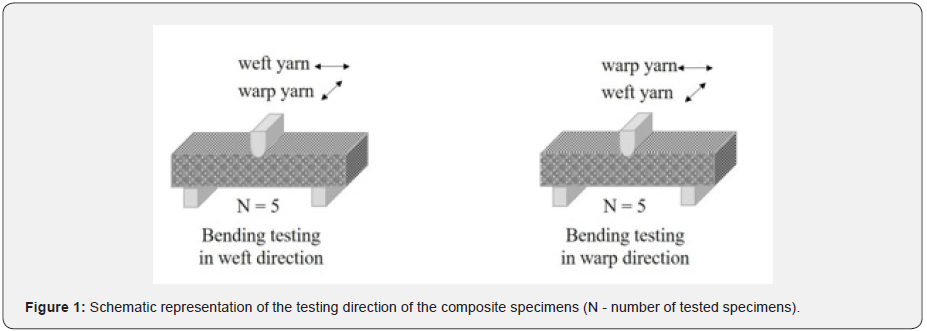
Results and Discussion
Microscope Imaging of the Coated Fabrics
The digital microscope images of the PEI coated flax textiles are represented in the (Figure 2). These images show that the PEI coating changes the color of the fabric making it browner. The increase of the PEI concentration leads to a darker brown color. The browning of the coated fabric is caused by the Maillard reaction between sugar and PEI [20]. According to the literature the cellulose-PEI mixture subjected to the increasing temperature shows no color change at 50 °C, a light brown color is observed at 100 °C and dark brown at 160 °C [12]. Since in this study the PEI coated fabrics are dried at 80 °C, the discoloration represents an expected reaction of the coating. It has already been shown in the previous studies that at the microscopic level the PEI is adsorbed on the cellulose surface as particles and not as a layer [19,21]. The amount of the PEI adsorbed on 8 flax fabrics used for the manufacture of one composite specimen is listed in the (Table 2). The amount of the PEI adsorbed on the fiber surface is analyzed gravimetrically by weighting the fabric before and after the PEI coating. The results show that the amount of the adsorbed PEI increases proportionally to the used concentration until the concentration values of 15 wt% is used. Probably, the use of too high amount of PEI leads to the displacement and agglomeration of the PEI towards the wooden frame. Consequently, the textile samples used for composite manufacture contained only a part of the sprayed PEI.
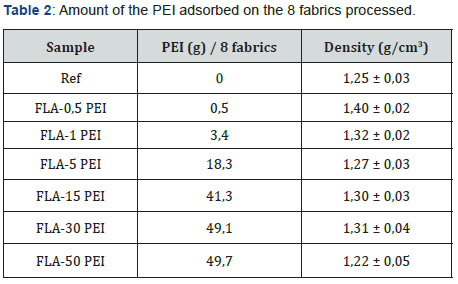
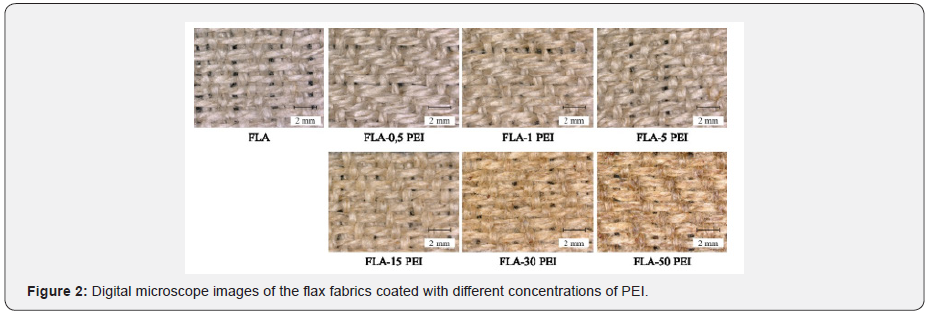
Density Measurement of the Biocomposites
The results of the density measurement are also presented in the (Table 2). Nearly all of the fabrics coated with PEI possess higher density than the reference sample. The highest density values correspond to the composites, which include flax fabrics coated with 1 wt% and 5 wt% PEI, 1,40 g/cm3 and 1,32 g/ cm3, respectively. Furthermore, it could be said that the further increase of the PEI concentration leads tendentially to the lower mean density values with higher standard deviation. Since PEI reacts both with cellulose [12] and with epoxy [16], possibly the lower concentration of PEI promotes better infiltration of the textiles with the epoxy resin. Consequently, this results in a lower amount of air inclusions inside the composites and thus, a higher density compared with the reference. PEI remains as an agglomerate on the fiber surface [19,21] and in the composite [19] and the chemical reaction with epoxy takes place merely at the interphase between the PEI agglomerate and epoxy resin [16].
Therefore, it can be assumed, that the higher PEI concentration leads to the formation of large agglomerates, which remain at the fiber-matrix interphase unreacted and act as contamination. These contaminations disturb the quality of the fiber-matrixinterphase and can lead to the formation of air inclusions between them. In order to prove this assumption, the cross-sections of the composite specimens were subjected to microscope imaging. The microscope images of the cross-sections are demonstrated in (Figure 3). A very strong defibrillation can be observed at the cross-section of the reference sample specifying very low impregnation with the polymer matrix. This is caused by the high fiber-matrix-fraction and poor fiber-matrix adhesion. The specimens with the fabric coated with 0,5 wt%, 1 wt%, 5 % and 15 wt% of PEI possess significantly less defibrillation in crosssection, with the 15 wt% leading to the best result. The specimens with higher PEI concentrations have numerous air bubbles in their cross-section, explaining the reduction of the density and high deviation of the measured density values.
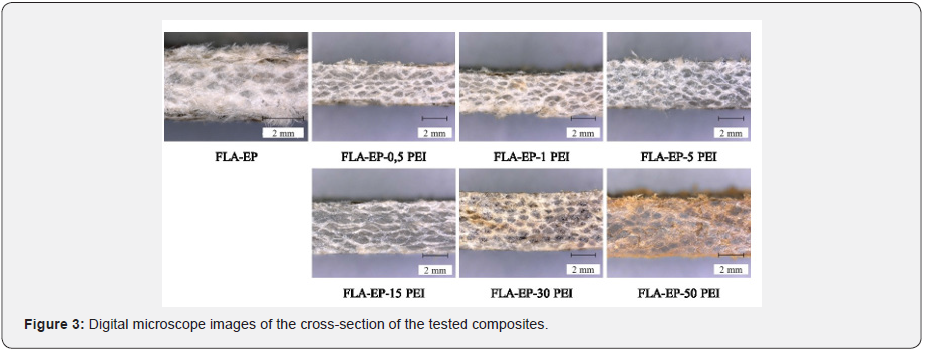
Bending Properties
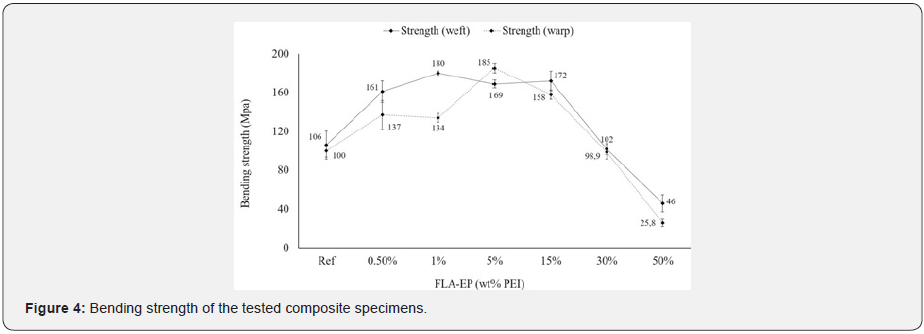
The bending strength of the composites tested in warp and weft directions is presented in the (Figure 4). The values of the reference composites showing 100 MPa and 106 MPa are comparable with the literature values of unidirectional flax fiberreinforced epoxy composites possessing strength of 190 MPa and 218 MPa[9]. The results show that the PEI coating leads to the improvement of the bending strength in both testing directions. The overall tendency that nearly all of the values in weft direction are higher than those in warp direction can be explained by the parameters used for the textile manufacture incl. twist of the used yarns, yarn counts, resulting crimp, etc. [18]. In the weft direction the 1 wt% PEI results in the highest bending strength, which is approx. 70 % higher than the corresponding reference. The further increase of the PEI concentration, like e.g. 15 wt%, leads to lower and / or unstable results. In the warp direction the highest value of 185 MPa, which is 85 % higher than the refence, is achieved using 5 wt% PEI. Starting from the 15 wt% the PEI coating reduced the bending strength of the composites drastically, so that the extreme high concentration of 50 wt% results in values considerably lower than the refences. The bending modulus of the tested composites is presented in the (Figure 5). In general, the tendency is comparable with that of the bending strength, i.e. the mild concentrations of PEI, namely 1 wt% and 5 wt%, lead to the highest improvement of the bending modulus, while higher concentrations reduce the modulus extremely. According to the density measurement and microscope images of the cross-sections of the specimens this extreme reduction of the bending properties is caused by air inclusions, and probably by the PEI agglomerates acting as a contamination at the fiber-matrix-interphase.
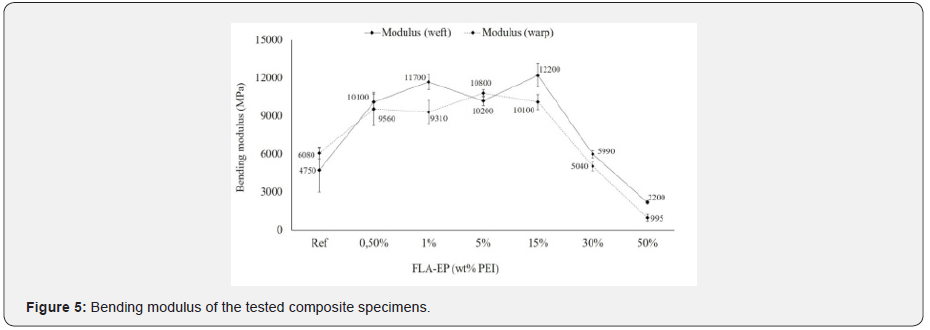
Conclusion
In this study the influence of the PEI coating is investigated with regard to the improvement of bending properties of the flax fiber-reinforced biobased epoxy resin. The results show that the PEI concentrations of 1 wt% and 5 wt% represent an optimal concentration range. Depending on the tested direction the concentrations lead to the increase of the bending strength to about 70 % or 85 %. At the same time the PEI coating has a minimal effect on the density of the resulting composites corresponding to an increase of about 2 % to 5 %. Although the main findings of this study show that the PEI coating offers a promising solution for the use as a coupling agent in the natural fiber-reinforced composites, there are still a lot of scientific questions, which have to be answered, in order to realize the potential of this approach. As an example, further optimization of the applied procedure with regard to the smaller concentration steps, used coating method, e.g. dipping instead of spraying, as well as the used substrate, e.g. plain, satin weaved fabric or unidirectional fabric would provide a good basis for the further research. Due to the large number of the influential parameters involved, probably, the use of Design of Experiments would be a suitable approach to carry out such an extensive and systematic study.

Comments
Post a Comment